Gold, Guns and God: Vol. 1—A Crazy Man
A Biography of Swami Bhaktipada and a History of the West Virginia New Vrindaban Hare Krishna Community in Ten Volumes by Henry Doktorski
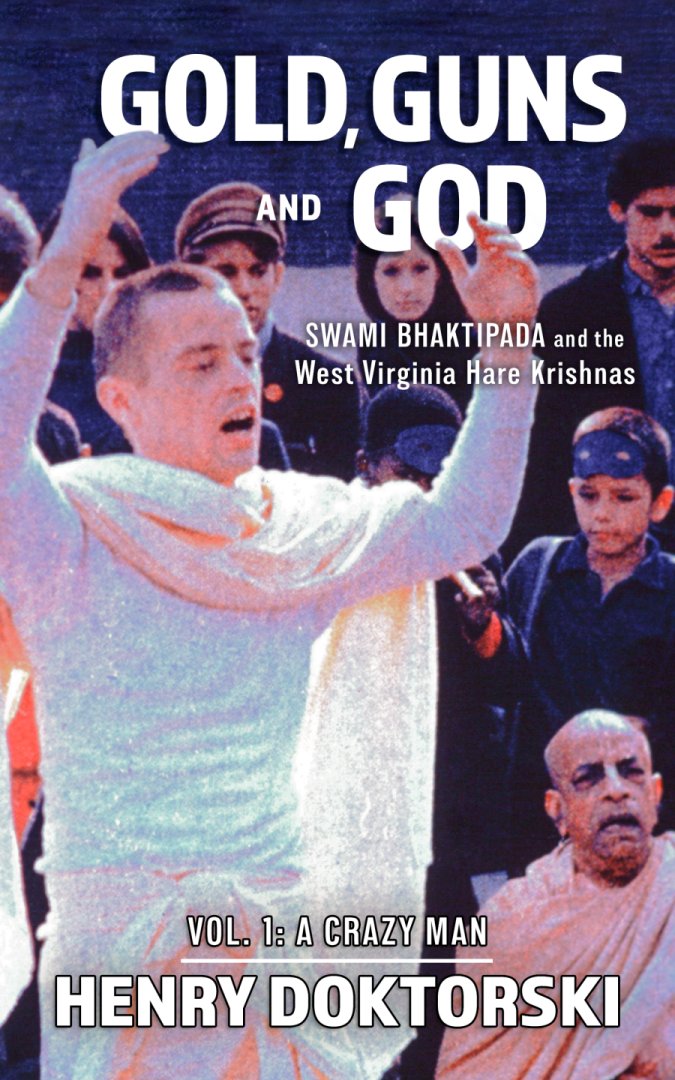
The cover of Gold, Guns and God, Vol. One: 70-year-old Bhaktivedanta Swami (seated) and 29-year-old Kirtanananda dasa Brahmachari (standing) during kirtan at Thompkins Square Park, New York City (c. October 1966)

Back cover image: Bhaktivedanta Swami and Kirtanananda dasa Brahmachari at 26 Second Avenue, New York City.
Henry Doktorski’s landmark 428-page non-fiction book about Swami Bhaktipada and the West Virginia Hare Krishna commune called New Vrindaban, can be purchased in several ways:
(1) Save money and purchase directly from the author: Send a check or money order (or use PayPal or Venmo) for $19.99 (includes shipping to anywhere in the United States). Send an email to the author and request address. Credit card payments must go through PayPal or Venmo. Send PayPal payment to the author at the e-mail address listed below. Canadian and overseas customers can pay with Western Union and must inquire directly from the author regarding shipping prices.
(2) Purchase from eBay here.
(3) In USA, purchase from Amazon.com.
(4) In Canada, purchase from Amazon.ca.
(5) In Mexico, purchase from Amazon.com.mx.
(6) In Brazil, purchase from Amazon.com.br.
(7) In Great Britain, purchase from Amazon.co.uk.
(8) In France, purchase from Amazon.fr.
(9) In The Netherlands, purchase from Amazon.nl.
(10) In Spain, purchase from Amazon.es.
(11) In Germany, purchase from Amazon.de.
(12) In Italy, purchase from Amazon.it.
(13) In Japan, purchase from Amazon.jp.
(14) In Australia, purchase from Amazon.com.au.
(15) In India, purchase from Amazon.in.
(16) Kindle readers, purchase from Amazon Kindle.
In addition, please “Like” Gold, Guns and God on Facebook!
Vol. 1 of Gold, Guns and God begins with the birth of Keith Gordon Ham in September 1937, and ends thirty years later in December 1967 when Keith (now known as Kirtanananda Swami) is banned from the New York City ISKCON temple and moves in with his best friend and former (we assume) lover, Howard (Hayagriva), in Wilkes-Barre, Pennsylvania.
Chapter One examines the genealogy of the Ham family; Keith’s childhood in Peekskill, New York; his strict Baptist upbringing; and his affliction as a junior in high school with the dreaded paralyzing disease: polio. During his senior year in high school, Keith develops a reputation as a heavy drinker and party animal, although he also serves on the student council, is elected to the National Honor Society, and graduates with honors. This chapter could not have been written without the generosity of Keith’s older brother, Gerald Ham, and his sharing the Ham Family Archives with the author.
Chapter Two deals with Keith’s college days, and his rejection of the strict Protestant religious principles espoused by his parents. As a graduate student at the University of North Carolina at Chapel Hill, he meets the most influential person in his life up to that time: his life-long best friend and lover, Howard Morton Wheeler. This chapter culminates as Keith and Howard are threatened with an investigation due to a sex scandal and they resign from UNC.
As an aside, it is important to note that Chapters 2 through 7 would have been impossible to write if not for the discovery in the Keith Gordon Ham/Swami Bhaktipada Archives of two autobiographical typewritten manuscripts written by Howard Wheeler in 1966. These two priceless manuscripts were obviously treasured by Kirtanananda Swami and protected in his secret library for decades, as the manuscripts tell in great detail how the two lovers met in Chapel Hill, and their activities from 1960 to January 1966. The full story regarding the acquisition of this archive can be found in the Acknowledgements section at the end of this volume.
Keith and Howard’s lives as Bohemian graduate students in New York City are described in Chapter Three, including a few of their impulsive sexual adventures (they were not monogamous), including a hilarious visit to a Coney Island bathhouse where they are groped by dirty old men. For several months, they befriend a homeless boy; giving him food, shelter, beer and marijuana in return for sex. The boy turns out to be a source of great pleasure, but also great pain, especially for Howard, who grows emotionally attached to the boy.
Subsequent chapters discuss Keith and Howard’s discovery of marijuana, peyote and LSD, and the expanded consciousness they experience while under the influence of the hallucinogenic drugs. They ponder the nature of existence and the meaning of life, and they study religious texts, especially from Buddhism and Hinduism, in an effort to understand the Absolute.
Chapter Seven relates Keith and Howard’s September-October 1965 journey to India on a steamship to search for answers to their questions, their adventures in India smoking hashish “as powerful as Lord Krishna,” their eventual disillusionment of Mother india, and their return to New York City three months later in January 1966.
Howard’s serendipitous meeting, hardly 100 yards from his Mott Street apartment front door, with the Bengali Gaudiya-Vaishnava guru, A. C. Bhaktivedanta Swami, on a Lower East Side street corner, is described in Chapter Eight. Howard introduces himself to the Swami, and the Swami invites him to attend Bhagavad-gita classes at his little storefront preaching center at 26 Second Avenue called “Matchless Gifts.” Howard brings along his two housemates to the class, Keith Ham and Wally Sheffey.
All three spiritual seekers are attracted to Swamiji (the name he was known at that time to his followers) and his teachings, and within two months all three formally accept Swamiji as their spiritual master. Keith becomes Kirtanananda, Howard becomes Hayagriva, and Wally becomes Umapati. Kirtanananda serves in the kitchen (Swamiji affectionately calls him “Kitchen-Ananda”) and Hayagriva, who taught English at Ohio State University a year earlier, serves as Swamiji’s editor. Swamiji calls him “Professor Wheeler.” Kirtanananda especially is regarded as a serious student; he is one of the first disciples to shave up, wear a dhoti, and move into the temple.
Swamiji’s history is briefly discussed, his childhood in Calcutta, his marriage, meeting his guru Bhaktisiddhanta Sarasvati Thakur Prabhupada, writing and publishing Back to Godhead, founding the League of Devotees, becoming a swami, and his journey to the United States. A summary of the philosophy and beliefs of Gaudiya-Vaishnavism is also presented.
Chapter Eleven describes Swamiji and Kirtanananda’s trip to India, where, in August 1967, twenty-nine-year-old Kirtanananda becomes Swamiji’s first disciple to accept the order of sannyasa, the most honored ashram in Hinduism. A sannyasi vows to renounce the world (including family and sex) and dedicates himself fully to preaching Krishna consciousness. After the initiation ceremony, held at the Radha-Damodar temple in Vrindaban, Swamiji announces—perhaps a bit prematurely—that “Kirtanananda is now a fully Krishna conscious person.”
Within a fortnight, however, Kirtanananda Swami causes quite a shock to Swamiji when he disobeys his spiritual master, returns without permission to New York, and attempts to convince his godbrothers to reject some of Swamiji’s teachings and adopt Kirtanananda’s “new and improved” methods for preaching Krishna consciousness in the West. The bewildered New York devotees write to Swamiji in India requesting clarification, and Swamiji condemns the actions of his first sannyasa disciple, calling him a “crazy man.”
Kirtanananda is banned from the temple and spat on. In retaliation, he takes Bhaktivedanta Swami’s Bhagavad-gita manuscript from Hayagriva and tries to sell it himself to religious book publishers. He sends nasty letters to Swamiji and others. This volume concludes with an analysis of what defines a cult, and how ISKCON fits within that description.
Gold, Guns and God, Vol. 1 now available in an Italian edition: Oro, Pistole e Dio: Vol. 1— (May 2024)

September 5, 2021: Five Stars—A Spiritual Criminal
Overall, Kirtanananda “Swami” is an extremely confusing study both devotionally and morally. He was very intelligent and convincing as far as Krishna consciousness is concerned. And there is no question that he was very dear to his guru, Srila Prabhupada, at least during periods of Srila Prabhupada’s manifest presence prior to 1978. Yet, the author paints a very detailed picture of his ambition, something Srila Prabhupada was largely able to control through peer pressure and Kirtanananda’s emotional attachment to him. Of course, his positives are contrasted with this and his homosexual promiscuity, the level of which most readers will not be able to imagine. The author also provides some evidence that, even as a devotee and “Swami” under strict vows, this only ceased for brief periods.
Being also a product of the 1960s, Kirtanananda was the type of hippie who others admired. He went to India on a spiritual search and otherwise exemplified the counterculture. He was the first American to commit pretty wholeheartedly to his guru’s otherwise foreign, Indian cultural demands for his disciples. Although many, in the light of his later life’s scandals, pretense and audacity, will see his early superlatives as little more than a prelude to his later self-absorbed ambition, there are a number of testimonies from others of his example and guidance. The author highlights a quote by Lord Krishna from the Mahabharata at the book’s beginning, “No good man is entirely good; no bad man is entirely bad.” Kirtanananda more than fits the bill. It is hard to refute his positives.
Rather than thoroughly condemn him, something I have been inclined to do many times in the past, I found myself wondering what might possess myself if I found myself in the prominent and privileged position he achieved in his guru’s society so early. In terms of Krishna conscious philosophy, it seems clear that Kirtanananda had been a disciple of some Vaishnava (Vishnu worshiper) or quasi-Vaishnava guru in a past life. It may have been Srila Prabhupada. However, his early offenses in this life are also detailed at the end of vol. 1, and his overall saga through the following books will bring out that many more. Kirtanananda was, in the end, a charlatan’s charlatan. In many ways he set the substandard for so many of the other Hare Krishna movement so-called guru cheaters, a paradigm which has ruined so many both spiritually and emotionally, at least for a number of their years. It is debatable as to whether Srila Prabhupada’s good will was there for him at the time of death. These books would be better classified in the true-crime genre.
Eric Johanson
Moab, Utah
Amazon review
January 16, 2021: Five Stars—Disturbing, eye opening, exciting, and relevant - a must read!
I had to put this book down several times due to its graphic and sexual nature. This part is not even the author’s writing—it’s entirely the unpublished diary of Howard Wheeler (and all I can say is Holy Crap!). Please be warned that the sexual (homosexual) escapades, seduction of a minor, and deviant behavior is entirely captured in great detail in the first person. Brace yourself as you will be introduced to a world I was completely unfamiliar with—the promiscuous world of anonymous male homosexual encounters—going to public bathrooms and other places for gratification.
From a historical perspective, the work laid out in this volume will shed plenty of light and help us understand how New Vrindaban came to be. Additionally, it is now easier to understand why the demise of New Vrindaban came to be under Keith Ham.
From a broader perspective, this book is extremely relevant and important in today’s political landscape. ISKCON and Prabhupada’s prescription that, “the spiritual master is never at fault! And even if he is, it is your duty as his disciple to do whatever he asks” set up the perfect framework from which Keith could operate, exploit, deceive, sexually abuse children, lie, steal, and deviate philosophically in New Vrindaban. It made me super sad to read that Prabhupada had very serious problems with Keith from the very beginning. The writing was already on the walls of 26 Second Avenue.
Reading this book was frightening, as the parallels between Keith and Trump turn out to be examples of the dangers of “deranged devotion.”
Pedro Ramos
Atlanta, Georgia
December 31, 2020: Five Stars—Brutally Honest
I finished this book stunned. I was aware of Kirtanananda’s dereliction, his poor character, etc., but this book strips away any pretense he may have had (and sadly still does in some circles) to being a guru, a holy man, or even a decent person. The quotes directly from his long time lover’s (Hayagriva) unpublished manuscript are extremely graphic and not for the feint of heart. What emerges from this important history of an ISKCON guru and community (New Vrindaban) is the story of fraud, sexual immorality, abuse, mythomania, narcissism, and a clear plan on the part of Hayagriva and Kirtanananda to hijack their little portion of ISKCON for power, money, influence, and sex.
This is an incredibly dark history that every ISKCON devotee, every disciple of Kirtanananda Swami Bhaktipada in India must read if they’re at all interested in truth. Henry Doktorski has pulled back the curtain of lies to reveal this part of ISKCON history warts and all, and does so without sensationalism. He simply presents the truth as it is and allows it to speak for itself. Amazing book! Highly recommended for students of world religion, new religions and cults, and apologetics.
Rev. Jack Davila-Ashcraft
from a review at Amazon

Rev. Jack Davila-Ashcraft
January 31, 2021: Five Stars—A well researched biography about a very unique person
This is Vol. 1 of a ten-volume biography of Swami Bhaktipada, a controversial leader of a controversial movement. For many years, Bhaktipada was one of the top leaders of the ISKCON movement, but he was expelled from that movement and started his own mission, for reasons that will hopefully be elaborated in later volumes of this biography. For the author’s own reasons, Volumes 3 and 5 were published before Vol. 1, and in the volumes that have been published, we can see that the author, Mr. Doktorski, has done a very good research about his former guru, and he is doing his best to give an honest story about Swami Bhaktipada’s life, both the good and the bad. This biography is also a very important part of the history of ISKCON, and especially the New Vrindaban community, for which Bhaktipada was the leader for a long time.
This biography also shows what a unique personality Swami Bhaktipada was. I don’t think any other ISKCON guru will have a ten-volume biography written about him.
G. R. S.
from a review at Amazon
June 29, 2021: Finally I started reading GGG Vol. 1. My mind is blown. There is so much details. Every decision has reaction, how life choices can change our course of life. I haven’t even gotten to the part where Keith meets Prabhupada, getting close to that part. I must say, it is well written, very impressive. Bravo.
Oh! and further I read & I couldn’t believe the subway stalls & university stall stories. I thought those occurrences were rare & not the norm. Boy, was I naive!!! I’m surprised Keith and Howard didn’t succumb to death from disease at young age from all the unsafe practices. They were very lucky indeed. They were so promiscuous. I feel like they never left their wild ways, just more discreet.
I’m amazed that such a sex maniac as Keith was able to achieve the status of sannyasi and guru. How he had fooled so many for so long.
I’m enjoying tremendously reading this volume. I laughed out loud when I read about Keith and Howard’s first experience ingesting the hallucinogenic cactus! The peyote experience and puking in the shared bucket. Ewwww! :(
Dharmi Norton
Houston, Texas
former disciple of Kirtanananda Swami, initiated Bombay (September 1979)

Dharmi Norton
May 15, 2023: Henry Doktorski: It’s not every day someone calls me a “demon!” One former New Vrindaban resident shared a post of mine about ISKCON history on his Facebook page, “Interplanetary Istagosthi.” At the bottom of my post is a link to Gold, Guns and God, Vol. 1. This one fellow read the post, clicked on the link, saw the material on my page, and was horrified. He made the following comment on the post in an effort to warn others not to visit my pages. It just goes to show that you can please all the people some of the time, some of the people all the time, but never all the people all of the time.
Locana dasa: DEVOTEES BEWARE! Opening up this link to Henry Doktorski’s book will expose you to opinions about Srila Prabhupada and ISKCON that could be construed as outright blasphemy. I innocently clicked on his link and it opened up the dirty details about two of our former prominent ISKCON members; details of which are very contaminating to read about. So, Kirtanananda and Hayagriva had serious addictions. Is that worth writing about—to such an extent? Would Srila Prabhupada ever approve of a TEN volume book on the sordid secret lives of two of his disciples who rendered him valuable service? Not for a second! Why is Doktorsky writing this, really? Money must be the only objective, and tearing down the legacy of ISKCON. IMO this posting should immediately be taken down. Doktorski slyly tempts one to open up his post with the innocent history of Srila Prabhupada’s founding of the League of Devotees, then announces his book at the bottom which is only food for the crows and jackals. And he uses the Holy Name to con you in: “Hare Krishna” historian. He is an enemy of ISKCON, Srila Prabhupada, Lord Chaitanya and all the acharyas. While the sincere devotees are out on the streets blissfully chanting the Holy Names, he is publishing books for the masses entitled, Killing for Krishna, and Gold, Guns, God. Innocent people are attracted when they see the blissful devotees chanting and dancing on the street, but if they once see the covers of any of Doktorski’s books, would they ever THINK of allowing their children to associate with this movement? He is an enemy, undoing the devoted efforts of Lord Chaitanya’s sincere followers to spread the Prime Benediction for humanity at large. If this group [Interplanetary Istagosthi] was founded for spreading the pure messages of our acharyas, then the presence of such an enemy on here should be striken from this group without delay.
Henry: He continued with a personal message to my friend who shared my link:
Locana dasa: Hello, you requested that I join your group [Interplanetary Istagosthi] recently, so I accepted your kind invitation. But now I am finding that you are presenting a demon on here who is an enemy of our sacred movement. Please read my response to your posting of Doktorski’s book ads. He is not writing to help our movement become purified, or he would write articles only for the devotional community. No. He is writing to attract the public with salacious graphics, and his extensive detailed descriptions of the sins of these two men only serve to scare people away from our movement. If this is the purpose of your group, I’m leaving it. He is an enemy.
Comment by former ISKCON devotee Steven Gelberg: Henry, there is no mystery in why some devotees will react like that to your books. You are exposing truths that are painful to them and which they’re unable to process within their ISKCON-conditioned minds. They feel their most cherished beliefs and dogmas are under attack. Naturally they will attack back.
May 16, 2023: Different individuals will draw different conclusions after examining Volume 1 of Gold, Guns, and God (GGG1) by Henry Doktorski. GGG1 reveals the filthy lifestyle of Kirtanananda with disturbing clarity. A key inference I drew from GGG1 is that depravity and perversion were deeply ingrained in the psyche of Kirtanananda to such an extreme degree as to make it impossible for him to suddenly renounce his twisted sexuality. In my view, the man described in GGG1 is the same man presented in volume 2 (GGG2) and all of the remaining volumes. Deeply embedded wickedness, such as the kind chronicled in GGG1, does not suddenly vanish. Since Bhaktipada Kirtanananda’s basic character did not improve even after meeting Srila Prabhupada, it stands to reason that Kirtanananda founded New Vrindaban with dark intentions. However, the historical evidence Doktorski uncovered is more powerful than mere a priori reasoning. Therein lies an important contribution of GGG2, specifically Doktorski’s insights into the inauspicious founding of New Vrindaban.
When I was a graduate student at The Ohio State University, I attended a class at the Columbus Temple in which Radhanath falsely told us, “New Vrindaban started out as a nice place. Then it became a different place. Now it is a nice place again.” Although Bhaktipada Kirtanananda advertised New Vrindaban as a divine sanctuary, it was a place of perversion from the start. His is not a story of a benevolent visionary who later became corrupt when he subsequently acquired power. Kirtanananda created an image of absolute dedication to Srila Prabhupada, while also deceiving and disobeying Prabhupada. Kirtanananda’s goal was to move Srila Prabhupada aside.
Chand Prasad Maryland, USA
May 17, 2023: Chand Prasad—brilliant analysis and spot on. To understand Keith Ham starts with learning about his persona and behaviors prior to meeting Prabhupada. As you point out, meeting ACBSP does not mean a switch turns off and his old habits, impulses, and nature suddenly disappear. This is one of Henry Doktorski III’s great contributions with the GGG Decalogue. We are afforded a thorough exploration of this complex character who disobeyed Prabhupada multiple times since Day One and was even kicked out of the movement more than once. I’ve always noticed—the writing was in the walls of 26 Second Ave. This may be an invitation to reflect on when we should forgive someone and welcome them back vs. understanding their potential for causing harm and irreparable damage so we stay/keep them away at all cost. It is a difficult predicament and also unfortunate when we explore the history of ISKCON.
The key question is: when to forgive. I have been wrestling with this for a long long time. When is someone bad enough that we should bypass our compassion, understanding, and humanity and completely discard them vs. finding it in our hearts to forgive them, accept that like all of us we are not entirely good or bad, and welcome them back in our lives? Definitely not an easy dilemma. However, the Keith Ham story proves that there are some clear signs that show past behavior is the best predictor of future behavior, regardless of what he said; hence, actions speak louder than words. We may ignore this lesson at our personal and collective risk.
Pedro Ramos Atlanta, Georgia
Chapter 1: This Child Is Going to be a Great Preacher
Genealogy
Rev. Francis Gordon Ham
Keith Gordon Ham
Living on a preacher’s salary
Strict Baptist upbringing
Keith is “born again”
Boarding school
Polio
High school graduation
The life of the party who always keeps the beer bottles empty
The Ham family moves to Long Island
Keith goes to college
Keith’s declaration of independence
Chapter 2: A Couple of Wild and Crazy Guys
Discovering the pleasures of the flesh
At the University of North Carolina
A propitious meeting
Howard tests Keith
The sex scandal
Chapter 3: The Big Apple
Living on West 20th Street
Keith and Howard’s “first anniversary”
Keith and Howard acquire a boy
New Years Eve at Time’s Square
Chapter 4: Denizens of Mott Street
Keith enrolls full time at Columbia
Howard begins his master’s degree program
Hunting for sex partners at a Coney Island bathhouse
Jimmy returns
Chapter 5: Weed, Sex, Booze, Violence and Dropping Out of School
Discovering marijuana
The Hudson Hornet
Keith and Howard’s country cottage
Howard smashes a beer bottle on Keith’s skull
Keith drops out of school
Howard receives masters degree
Chapter 6: Tripping
Jimmy robs the Mott Street apartment
Peyote
Howard flips out
Wally joins Keith and Howard
Keith, the LSD guru
Spiritual seekers
Chapter 7: Passage, O Soul, To India!
Crossing the Atlantic
Docking in Egypt and Yemen
India at last!
Hardwar
Delhi and Calcutta
Chanting Hare Krishna
Chapter 8: Turning Hippies Into Happies
Meeting Swamiji
Swamiji’s childhood
Abhay De marries
Abhay meets his guru
Abhay’s marriage sours
Back to Godhead magazine
The League of Devotees
Tea or me?
Abhay becomes A. C. Bhaktivedanta Swami
The journey to America
Preaching in America
Hippies
Matchless Gifts
Chapter 9: The Spiritual Master Is Never At Fault
Gaudiya-Vaishnava siddhanta
The soul
Transmigration of the soul
Krishna: The Supreme Personality of Godhead
The material world: a prison for rebellious souls
Transmigration
Maya: the material energy
Transcendental knowledge is transmitted by disciplic succession
Chaitanya Mahaprabhu: the most recent incarnation
Qualifications of guru
Qualifications of disciple
The secret of success in spiritual life
Symptoms of a self-realized soul
Chapter 10: Keith Becomes Kirtanananda
Howard becomes Bhaktivedanta Swami’s editor
Keith becomes a serious student
Keith becomes the chief cook
The Sunday “Love Feast”
Decorating the “Temple”
Keith moves in with Swamiji
Keith shaves up and wears a dhoti
Sex in Krishna consciousness
Keith saves Howard and Wally
Visit to Ananda Ashram
Keith confined in a psychiatric hospital
The first initiation ceremony
Keith released from Bellevue
Keith becomes Kirtanananda
Swamiji opens a second temple in San Francisco
Establishing ISKCON Montreal
Chapter 11: Return to India
Swamiji suffers a stroke
Swamiji decides to return to India
Swamiji departs for India
Swamiji arrives in India
Kirtanananda becomes a swami
Chapter 12: A Crazy Man
Swamiji sends Kirtanananda to London
Kirtanananda disobeys Swamiji and returns to New York
Kirtanananda attempts to add cultural elements from Christianity into Vaishnavism
Chanting Om namah sivaya
Devotees write to their master in India
Swamiji plays the “part of a thunderbolt”
Kirtanananda banned from the temple; spat on
Kirtanananda and Hayagriva steal Swamiji’s Bhagavad-gita manuscript
Kirtanananda and Hayagriva threaten to start their own ashram in West Virginia
Swamiji still loves his “beloved son”
“Hayagriva is not as fanatic as Kirtanananda”
Kirtanananda reminisces
Addendum: The Cult of ISKCON
Characteristics of cults
Cults in history
The counterculture
Who joins cults?
The cult leader
The cult leader is infallible
Thought reform
Principles of thought reform
Unfreezing
Changing
Refreezing
Hyperventilation
The cult of ISKCON
Cult murders and suicides
ISKCON suicides: Vishnujan Maharaja
Taru dasa
Taru committed suicide?
Taru murdered?
Venkatachalapathi
Chota Haridasa and Taru “return”
Images
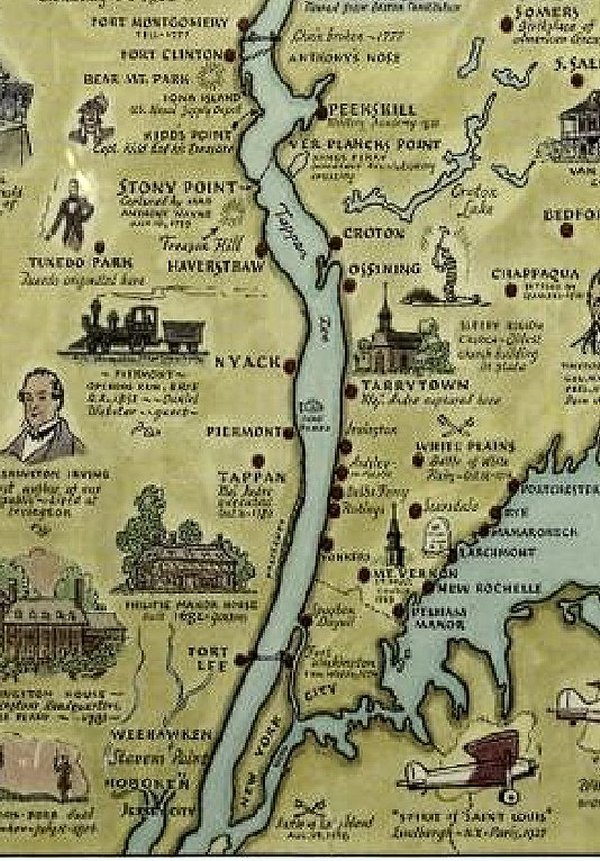
Map of the Lower Hudson River Valley showing location of Peekskill (upper center) in relation to New York City (lower center).
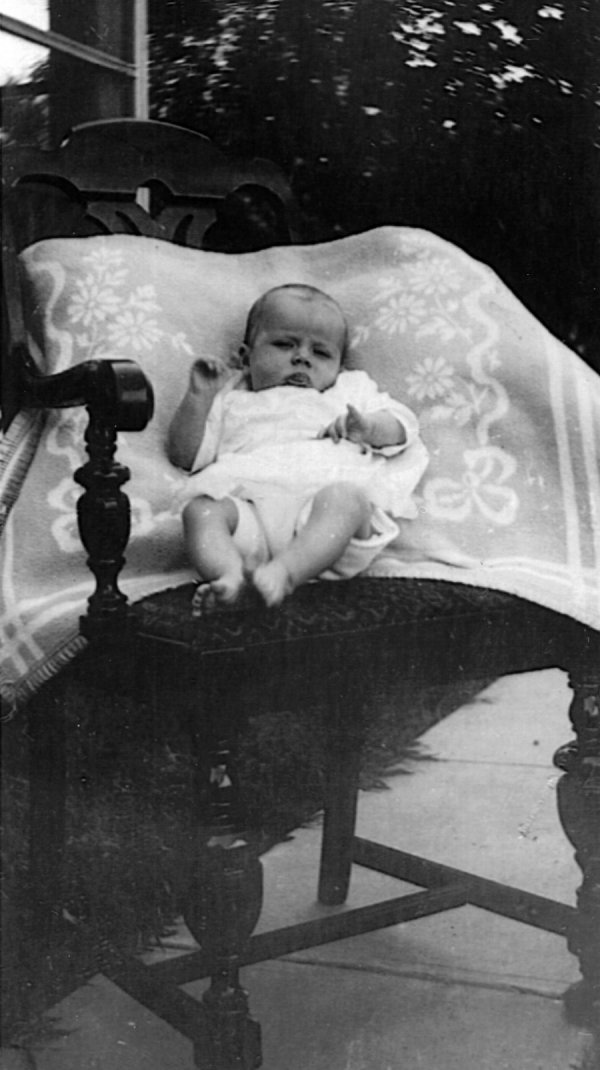
Keith Gordon Ham.
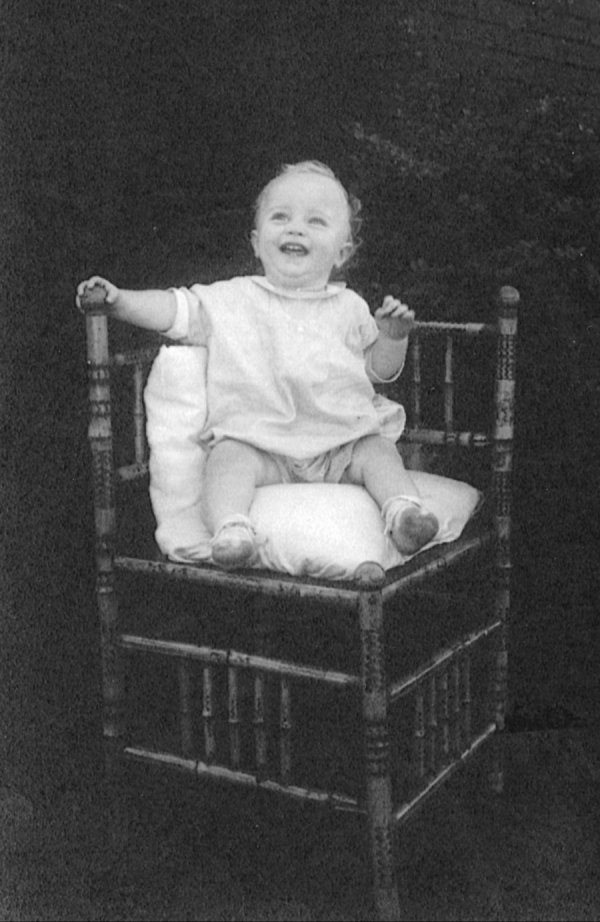
Keith Gordon Ham.
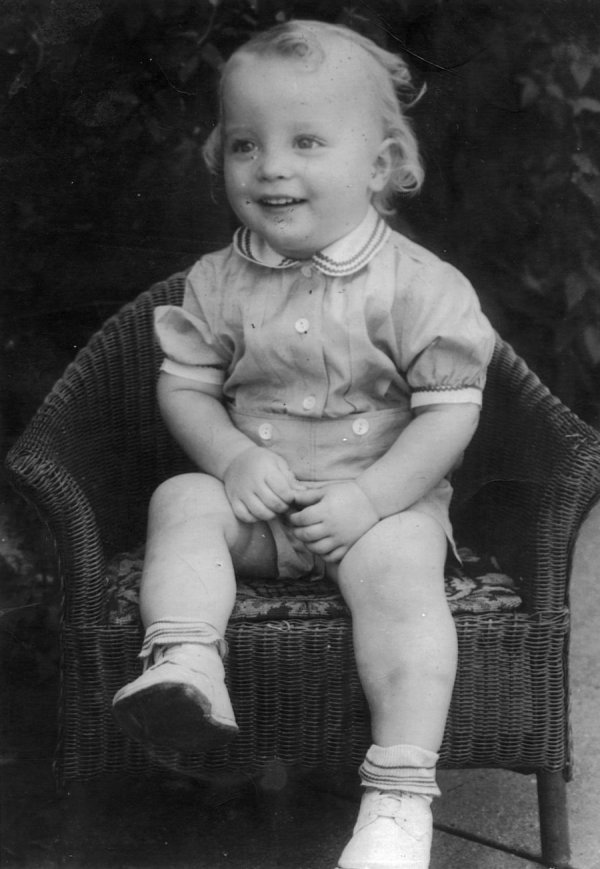
Sitting on a whicker chair.
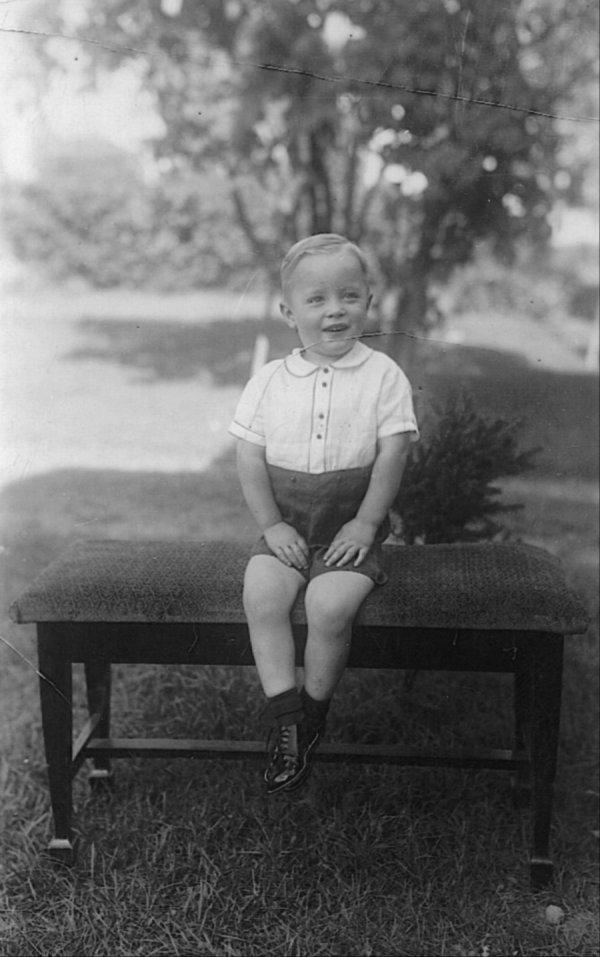
Sitting on a piano bench.
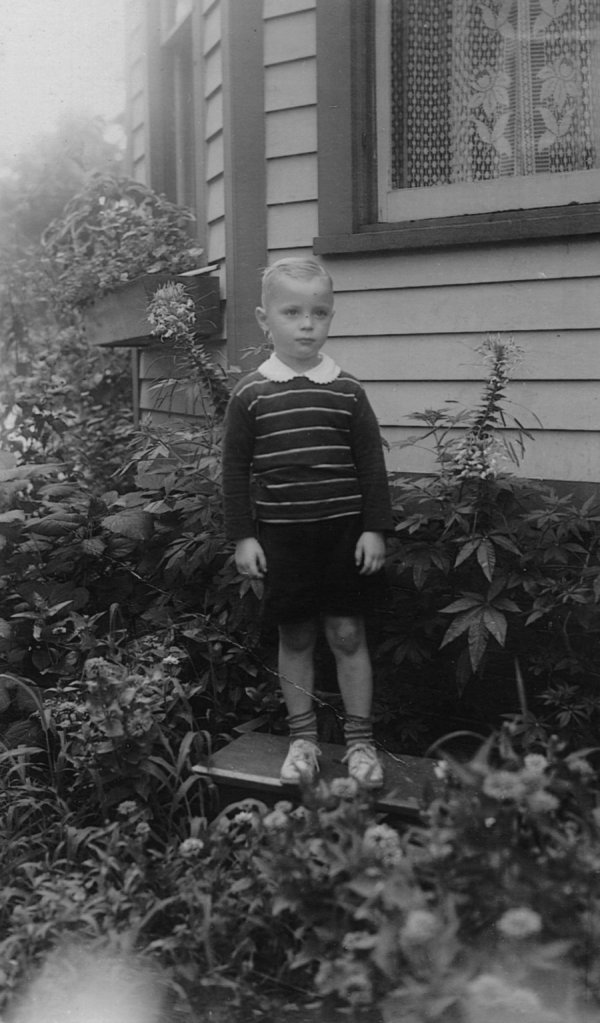
Standing on a bench in the garden.

The Ham Family: Joan, Gerald, Roberta, Shirley, Rev. Ham, Keith and Mrs. Ham.
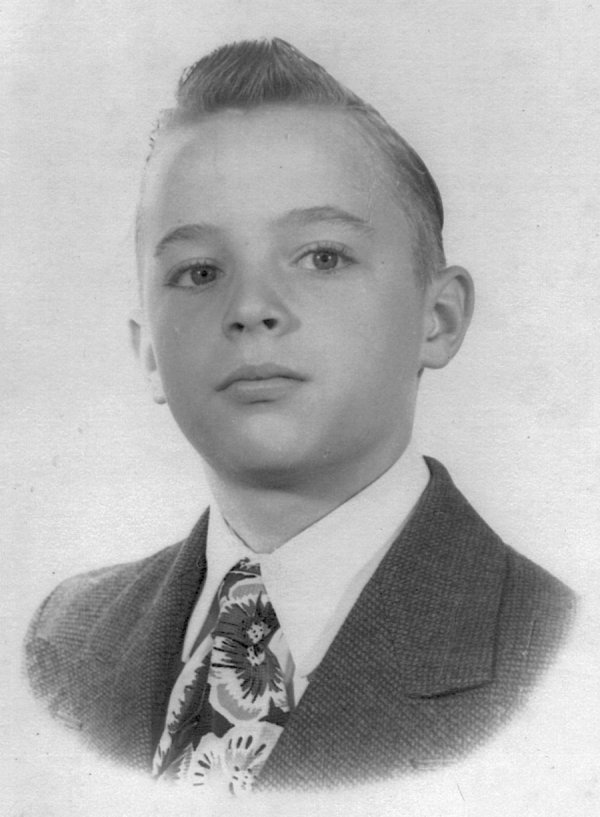
Keith's self-assured visage became a trademark look years later.
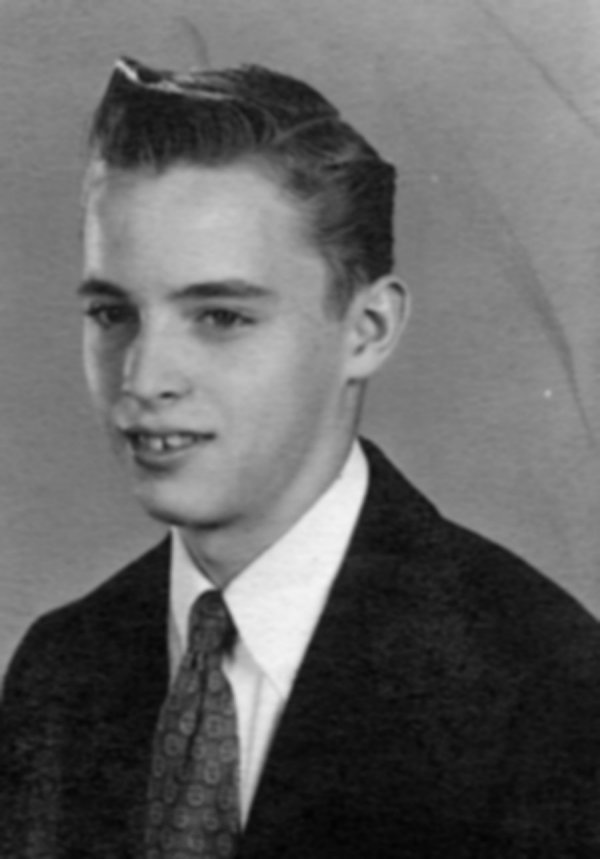
Junior high school photo.
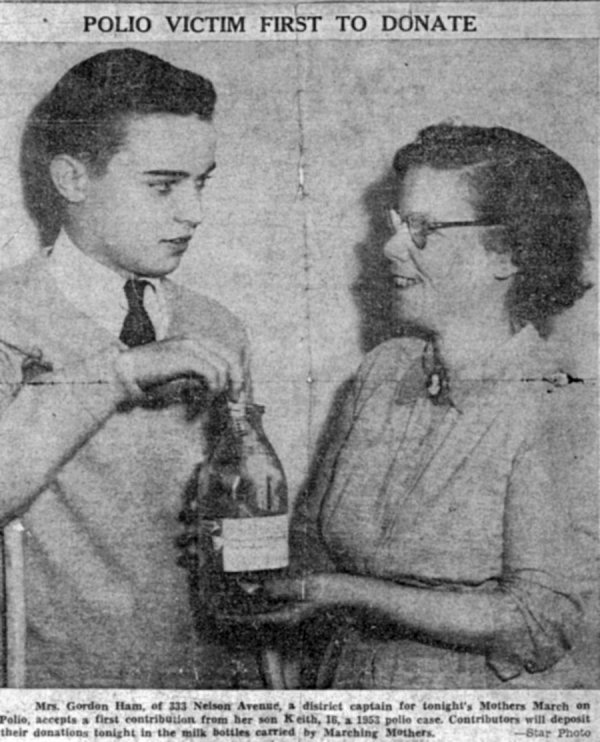
Peekskill Star newspaper clipping: “Mrs. Gordon Ham, of 333 Nelson Avenue, a district captain for tonight’s Mothers March on Polio, accepts a first contribution from her son Keith, 16, a 1953 polio case. Contributors will deposit their donations tonight in the milk bottles carried by Marching Mothers.—Star Photo.”
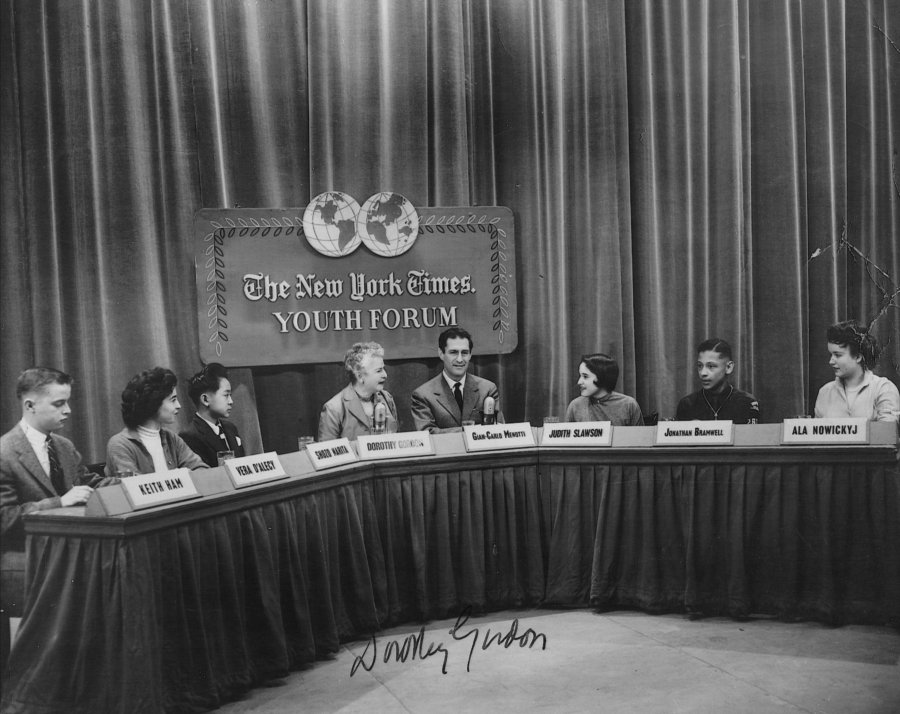
The New York Times Youth Forum with Gian Carlo Menotti.
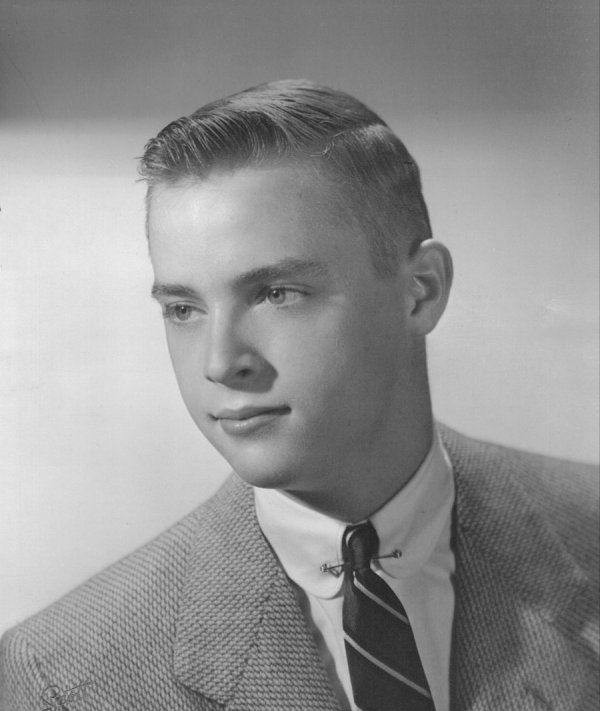
Peekskill High School graduation photo.
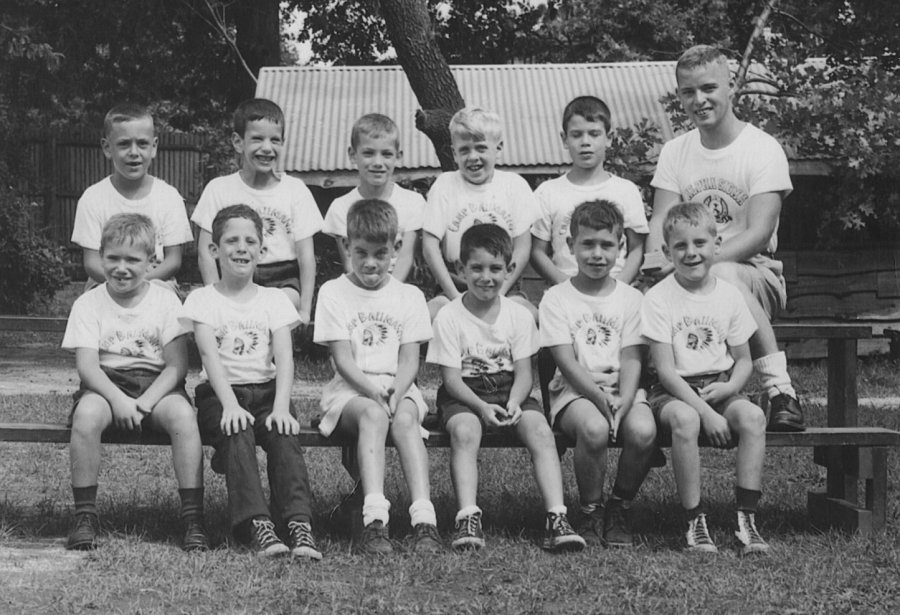
Keith and his boys at his summer job as camp counselor, Camp Bouman Day Camp, Long Island.
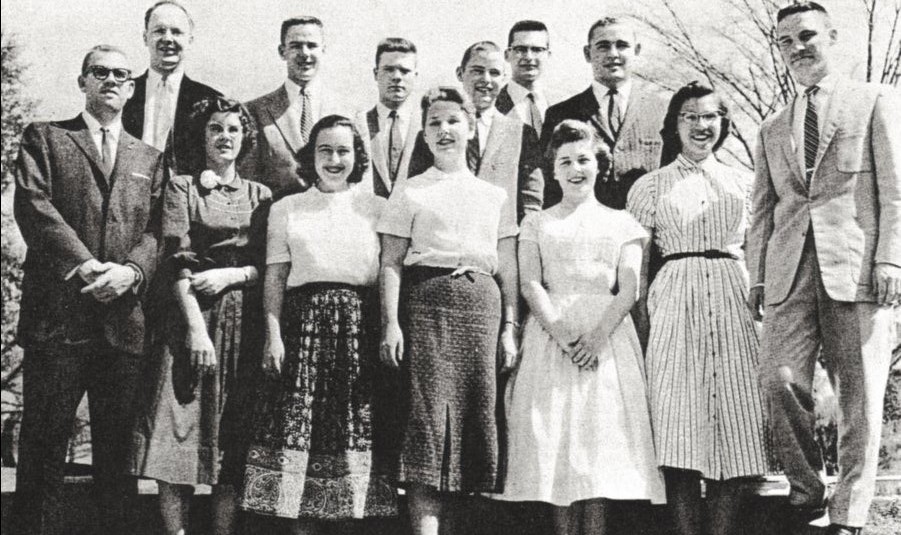
Maryville College debate team. Keith is in the center.
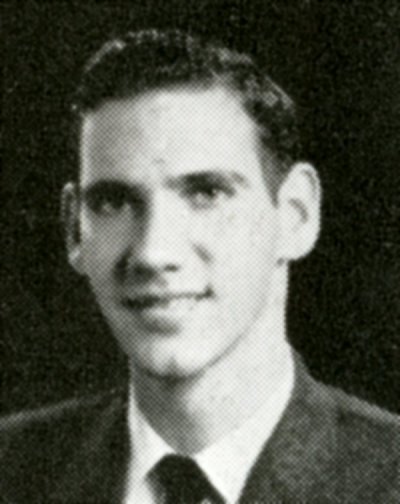
Howard Morton Wheeler, North Carolina University yearbook photo (1959).
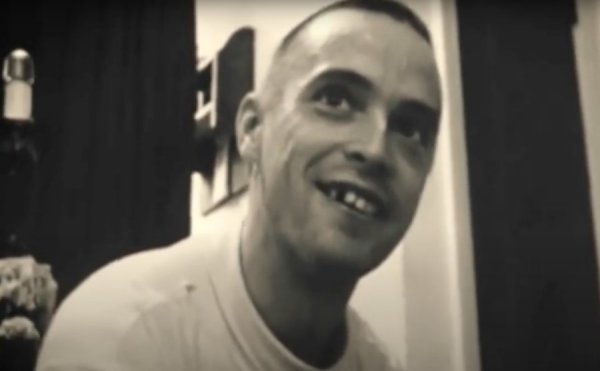
Kirtanananda dasa Brahmachari at 26 Second Avenue (1966).
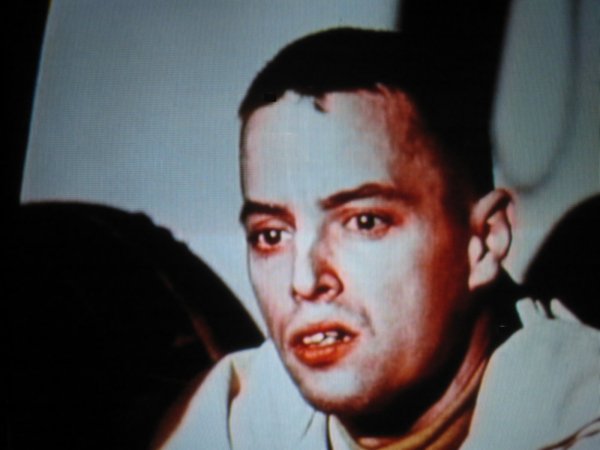
Kirtanananda (1966).
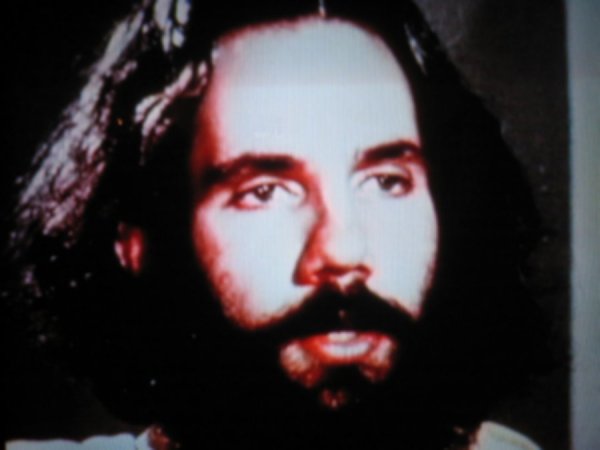
Hayagriva dasa Brahmachari at 26 Second Avenue (1966).
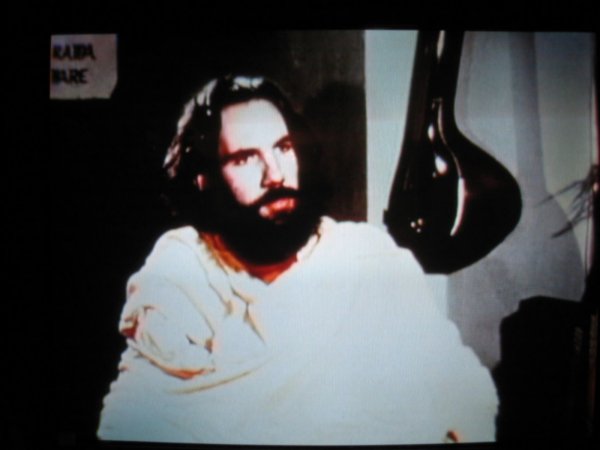
Hayagriva (1966).

Umapati (Wallace Sheffey) lectures at the American Center in Paris (1970).

Kirtanananda, Bhaktivedanta Swami and disciples at New York International Airport (July 22, 1967).
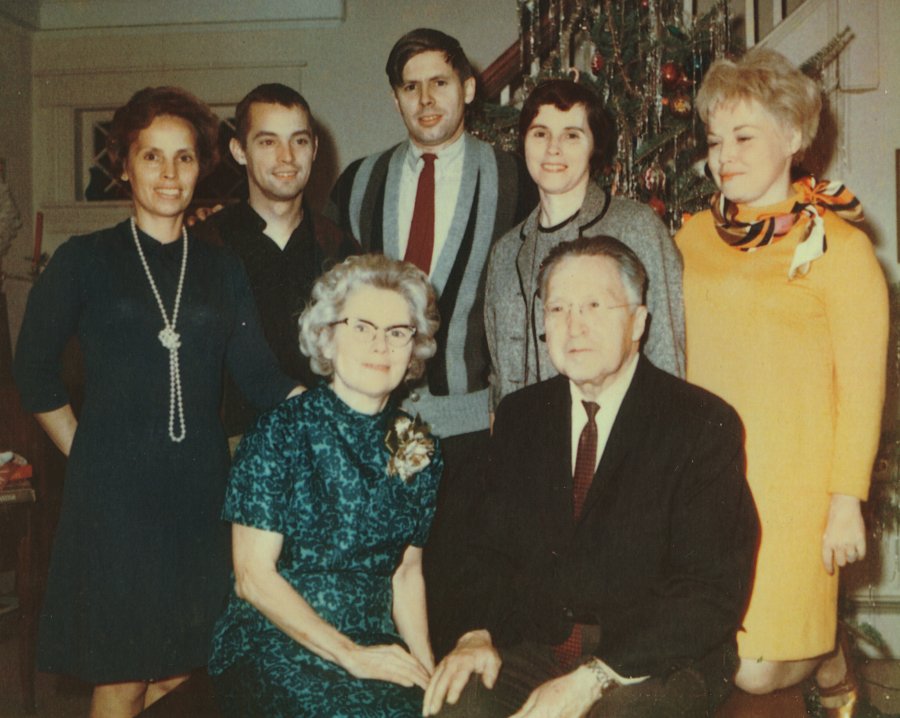
Kirtanananda “Swami” visits his family in Merrick, Long Island, during the Christmas holidays (December 1967). Shirley, Keith, Gerald, Joan, Roberta, and Mrs. and Rev. Ham.
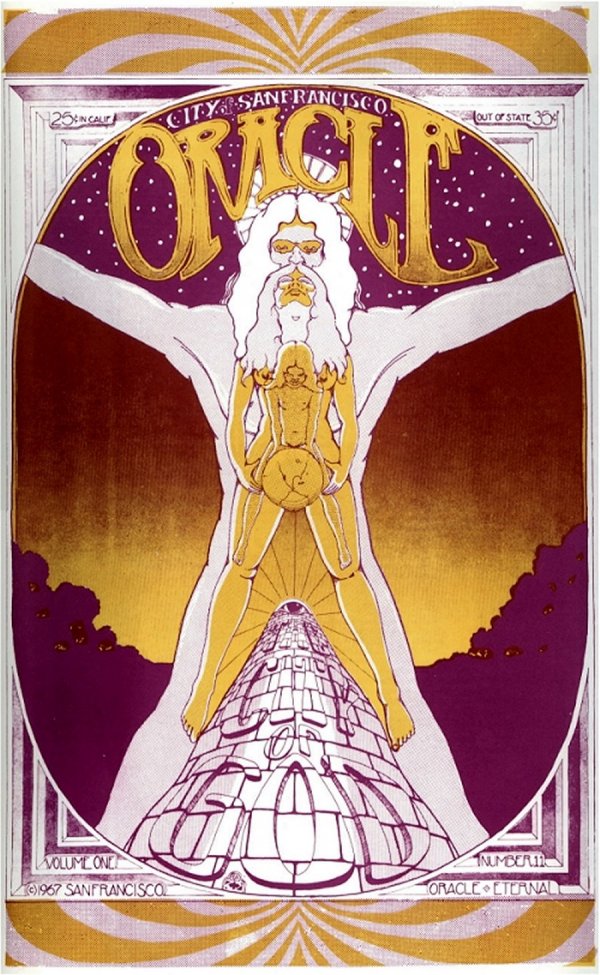
Cover of the December 1967 issue of the City of San Francisco Oracle.
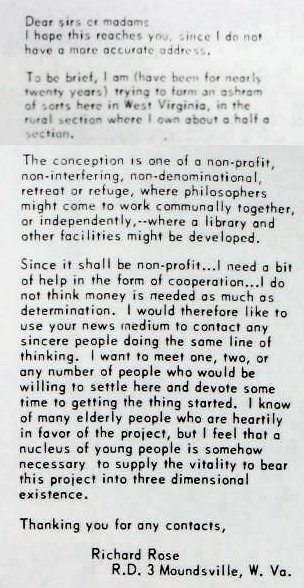
Letter from Richard Rose in the December 1967 issue of the City of San Francisco Oracle (Vol. 1, No. 11).
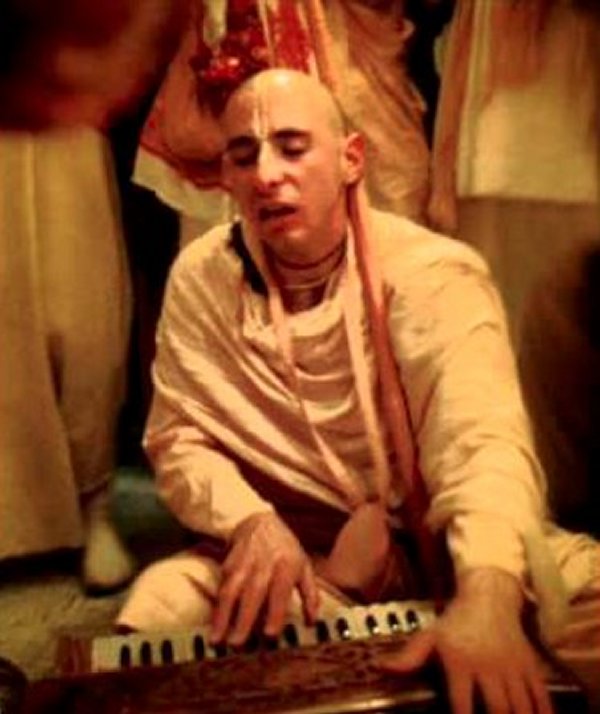
Vishnujan Maharaja (undated).
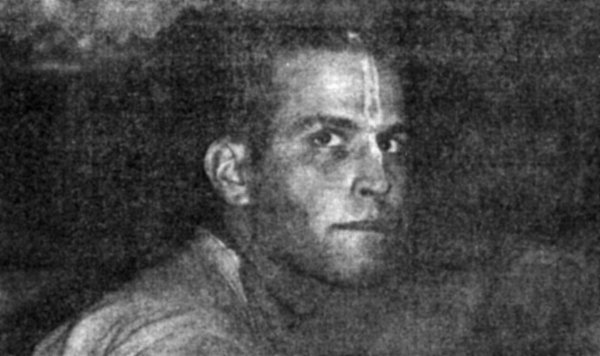
Taru dasa (Thomas Meyers), photo from Brijabasi Spirit, Vol. 4, Nos. 1-2 (February 1977).
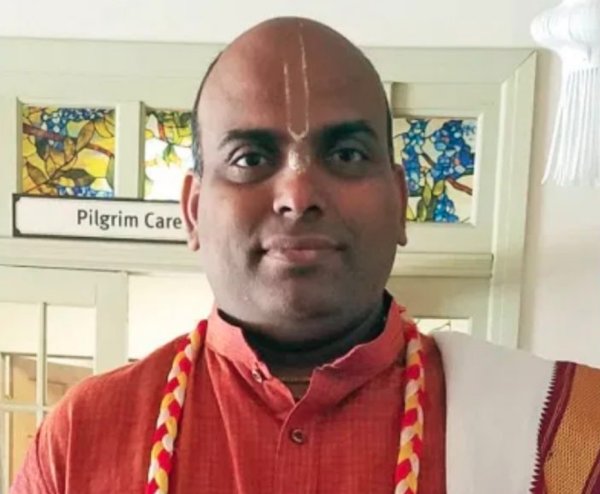
Venkatachalapathi in the New Vrindaban Life Membership office (undated).
| Back to: Gold, Guns and God |
